E. Howard & Co., Roxbury, MA
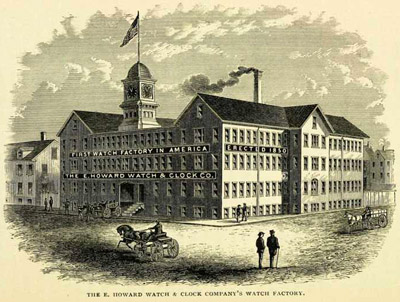 Boston Watch Company
Boston Watch Company
In 1849 Aaron Lufkin Dennison, Edward Howard and David Davis formed a company with a plan to use machinery to manufacture watch movement parts so precisely that they would become fully interchangeable. They initially outfitted space for design and manufacturing in Howard's clock factory in Roxbury, Massachusetts, a community neighboring Boston. In 1851 they moved to a new factory across the street from Howard's clock factory. Based upon the experience of earlier failed trials, Howard and Dennison eventually perfected and patented their precision watch making machines and create the American System of Watch Manufacturing.
In the spring of 1853 the first Dennison, Howard, & Davis watches were offered for sale to the public. The name was changed from Warren Mfg. Co. to Boston Watch Company in September 1853, and a new factory in Waltham, Massachusetts was opened in October 1854. The company produced pocket watches ranging from 7 to 15 jewels which found acceptance in the industry, fostering growth until the country began experiencing a recession in 1856. Sales dropped, debts climbed and bankruptcy became inevitable. The Boston Watch Company was sold at auction in April 1857.
E. Howard & Co.
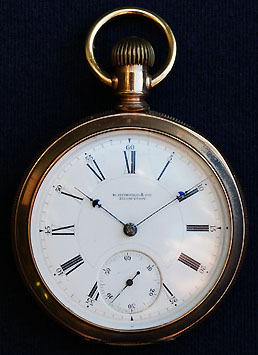 Following the failure of the Boston Watch Company, Edward Howard and his financial partner, Charles Rice, started E. Howard & Co. They acquired most of the material and watches in progress, along with some of the watch making machinery, based upon a lien against the defunct company held by Charles Rice. They were unable to buy the factory in Waltham and remaining machinery, being outbid by Royal E. Robbins (American Watch Company). They returned to the old factory building in Roxbury.
Following the failure of the Boston Watch Company, Edward Howard and his financial partner, Charles Rice, started E. Howard & Co. They acquired most of the material and watches in progress, along with some of the watch making machinery, based upon a lien against the defunct company held by Charles Rice. They were unable to buy the factory in Waltham and remaining machinery, being outbid by Royal E. Robbins (American Watch Company). They returned to the old factory building in Roxbury.
During their first year of operation, the remaining Boston Watch Company Model 1857 movements were completed and the machinery was retooled for the production of a new watch of Howard's design, a watch that was entirely different from previous watches. The movements were signed "E. Howard & Co." on the dials and "Howard & Rice" on the movements. The top plate was made in two sections and had six pillars instead of the usual four found in a full-plate watch and introduced the more accurate quick-train (i.e., 18,000 beats per hour, instead of 16,200) to the American market.
In December 1858 Howard bought out Rice's interest. Howard's goal was to produce watches of the highest quality using interchangeable machine-made parts. E. Howard & Co. became know for high grade watches, regulators, and marine clocks. In March 1861 the clock and watch businesses were combined into one joint stock corporation, the Howard Clock & Watch Company, reorganized as the Howard Watch & Clock Company in October 1863. Howard introduced the first stem-winding watch in 1868. The manufacture of key-wind movements was discontinued altogether by 1878. Howard was first to use the Reed patented micrometer regulator, and was the first to offer watches adjusted to six positions. The company targeted the high end of the market almost exclusively, and its products were prestigious as well as expensive.
E. Howard Watch & Clock Company was formed as a joint stock corporation on December 1, 1881, which purchased the plant of the old company. Edward Howard was elected President, after serving for one year he retired in 1882. Samuel Little succeeded him as President. The company continued to sell high grade watch movements and clocks in grades and styles established by Howard. The movements continued to be signed "E. Howard & Co. Boston."
All Howard watch movements were adjusted at least to isochronism. Around serial number 10,964 movements adjusted to both isochronism and temperature were marked "Heat & Cold" and, and movements fully adjusted to temperature, isochronism and positions were marked "Adjusted". After 1884 E. Howard & Co. movements were designated by categories of adjustments:
- I = isochronism only (hound symbol);
- HCI = heat, cold and isochronism (horse symbol);
- HCI6P = heat, cold, isochronism and 6 physical positions (stag symbol).
Between 1858 and 1903 the E Howard firm produced approximately 108,000 watch movements.1
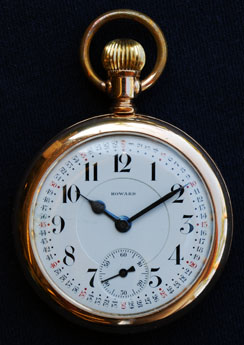 E. Howard Watch Co.
E. Howard Watch Co.
The Howard name in association with watches was purchased by the Keystone Watch Case Company in 1903. There were no patent rights transferred, just the Howard name. The watches of the Keystone era are typically marked "E. Howard Watch Co. Boston U.S.A." Initially watches were manufactured under contract by the American Waltham Watch Co.
The Philadelphia Watch Case Company merged with the Keystone Watch Case Company in 1904. Through this acquisition Keystone gained control of the former U. S. Watch Company factory in Waltham, Mass. where they began production of Keystone E. Howard Watch Co. watches in 1905. Keystone produced a line of high quality 16-size, 17 to 23 jewel watches.
Howard Watch Co. watches were marketed directly to railroad workers through railroad trade magazines. According to Howard's catalog in 1909 "All Howard Lever-Setting Watches are accepted and approved by the time inspectors of leading railroads."2 These watches were sold as complete watches only i.e. they were cased and timed at the factory.
In 1927 the Howard name was sold to Hamilton Watch Co. A limited number of pocket watches marked E. Howard Watch Co., based on Hamilton's grade 917 movement, were completed in 1939, Hamilton also produced wrist watches marked E. Howard Watch Co., based on Hamilton's grade 980 movement during the 1940's.
E. Howard Clock Co.
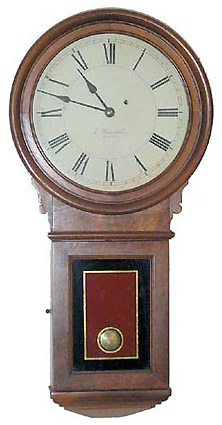 The E. Howard Clock Co. was founded 1842 in Roxbury, under the name Howard and Davis, their factory was completed in 1845. About 1843, with a third partner, Luther Stephenson, they began to also manufacture tower clocks. They also became known for their manufacture of sewing machines, fire engines and precision balances. In 1857 David P. Davis left the firm and Howard & Davis was succeeded by E. Howard & Company. In March 1861 the clock and watch businesses were combined into one joint stock corporation, the Howard Clock & Watch Company, which became called the Howard Watch & Clock Company following a reorganization in October 1863.
The E. Howard Clock Co. was founded 1842 in Roxbury, under the name Howard and Davis, their factory was completed in 1845. About 1843, with a third partner, Luther Stephenson, they began to also manufacture tower clocks. They also became known for their manufacture of sewing machines, fire engines and precision balances. In 1857 David P. Davis left the firm and Howard & Davis was succeeded by E. Howard & Company. In March 1861 the clock and watch businesses were combined into one joint stock corporation, the Howard Clock & Watch Company, which became called the Howard Watch & Clock Company following a reorganization in October 1863.
This firm primarily manufactured weight driven wall clocks and regulators of fine quality. Howard Watch & Clock Company weight driven 8-day regulator clocks were were known for their accuracy and were used as Standard Clocks in a number of railroad stations. The large Regulator No. 89, with a 12 inch dial and 65 inch tall case, Regulator No. 57, with a 14 inch dial and 74 inch tall case, and Regulator No. 60, with a 14 inch dial and 80 inch tall case were used in larger stations. Regulator No. 70, with a 12 inch dial and a 32 inch tall case was a commonly used model for smaller stations and offices. Regulator No. 70, was also available in larger sizes.
Following the sale of the Howard name in association with watches, the reorganized E. Howard Clock Company continued to produce clocks until 1933 when the company was incorporated as Howard Clock Products Co. which continues to produce clocks today.
E. Howard railroad grade watches (not all were railroad approved)
The following is from list of railroad grade watches which is generally attributed Webb C. Ball. Not all of these were railroad approved even though all are railroad grade.
E. HOWARD & CO.
- All Howard models marked “Adjusted” or deer symbol
- Split plate models, 18S or N size, 16S or L size
E. HOWARD WATCH CO. (Keystone-Howard)
- All 16S with 19, 21, & 23J
E. Howard & Co. Watch Production Series
E. Howard and Co. designated ranges of serial numbers for each series of watches. As multiple series were being produced at the same time, and gaps in serial numbers existed, production dates can only be estimated. E. Howard & Co. produced approximately 108,000 watch movements between 1858 and 1903.
| Introduction Year | Series | Size | First S# | Last S# | Key Features |
|---|---|---|---|---|---|
| 1857 | 18 | 6,001 | 6,482 | 16 jewels, KW from back, KS from front; Full plate; Most signed "Howard & Rice," or "Boston Watch Co." | |
| 1858 | I | N | 111* | 1,800 | KW/KS fr. rear; Divided plates on 6 pillars; Reed's barrel; Exposed stopworks, "quick beat" (18,000 bph). |
| 1859-60, Types D & E | II | N | 1,801 | 3,000 | KW/KS; Divided plates on 6 pillars; Rectangular cut-out between plates. |
| 1862-K | K | 3,001 | 3,090 | KW/KS; Reed's barrel; 3/4 plate, Straight regulator. | |
| 1862-N | III | N | 3,301, & 3,501 |
3,400, & 26,600; 27,580 |
KW/KS; Last Reed's barrel model, last model with Mershon's reg. Adjustment markings became standard. |
| 1863 | I | 3,401 | 3,500 | KW/KS; Balances: 3/4 plate from this model till the Model 1893. | |
| 1869 | V | L | 50,001 |
70,381, 150,002 | KW/KS, SW/PS, KW-SW transitional (rare), or SW/LS (rare); |
| 1871 | IV | N | 30,001 | 49,999 | KW/KS (early), or SW/PS (HC config) |
| 1874 | VI | G | 100,001 | 105,200 | KW/KS (rare, gilt only), or SW/LS (gilt or nickel, HC config); |
| 1883 | VII | N | 200,001 | 226,800 | 3/4 plate; Continuation of the Model 1871 ("Series IV"); All M1883 are SW/PS (HC config) |
| 1884 | VIII | N | 300,001 | 308,600 | 3/4 plate; SW/PS Open Face configuration |
| 1890 | IX | N | 400,001 | 405,000 | 3/4 plate; SW/PS; Hunting case configuration; Gilt Finish only; adjusted to isochronism only |
| 1891 | X | J | 500,001 | 501,400 | 3/4 plate; SW/PS; Open face configuration; Nickel finish. |
| 1893-HC | VII Ball Model, private label | N | 226,201 | 226,222 | 3/4 plate; Hunting case; 17 jewels; Breguet overcoil hairspring; All are marked "Adjusted" |
| 1893-OF | VIII Ball Model, private label | N | 307,401, & 308,101 | 307,500, & 308,450 | 3/4 plate; Open Face; 17 jewels; Breguet overcoil hairspring; All are marked "Adjusted" |
| 1894 | VII split plate | N | 228,001 | 230,100 | Hunting case; 3/4 plate; 17 jewels; Breguet overcoil hairspring; All are marked "Adjusted" |
| 1895-N | VIII split plate | N | 309,001 | 310,000 | Open face; 3/4 plate; 17 jewels; Breguet overcoil hairspring; All are marked "Adjusted" |
| 1895-L-HC | XI split plate | L (16) | 600,001 | 601,150 | Hunting case; 3/4 plate; 17 jewels (standard); Breguet overcoil hairspring; All are marked "Adjusted" |
| 1895-L-OF | XII split plate | L (16) | 700,001 | 701,330 | Open face; 3/4 plate; 17 jewels (standard); Breguet overcoil hairspring; All are marked "Adjusted" |
E. Howard Watch Co. (Keystone-Howard) Serial Numbers and Dates
| 1902 - 850,000 | 1909 - 980,000 | 1915 - 1,285,000 | 1921 - 1,400,000 |
| 1903 - 900,000 | 1912 - 1,100,000 | 1917 - 1,340,000 | 1930 - 1,500,000 |
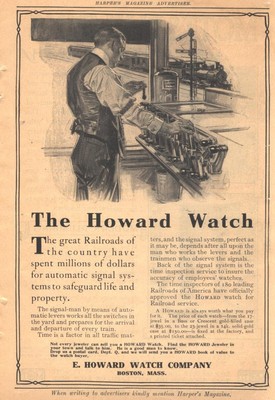 References and additional reading:
References and additional reading:
1 " Harold Visser and Clint Geller, "E. Howard & Co. Watch Movement Production Totals," on-line article on the NAWCC Chapter 174 website, Pocket Horology.
2 "Howard Watches, Howard Watch Co., Waltham, MA, 1909+, reprinted by American Reprints, St. Louis, MO, 1969.
Henry G. Abbott, The Watch Factories of America Past and Present: A complete history of Watch Making in America, from 1809 to 1888 Inclusive. Geo. K Hazlitt & Co. Chicago, 1888, reprinted by Forgotten Books, Lexington, KY, 2012.
Charles S. Crossman, The Complete History of Watch Making in America, Reprinted from Jewelers' Circular and Horological Review 1885 - 1887. Adams Brown Co. Exeter, New Hampshire.
Clint B. Geller, A Study of E. Howard & Co. Watchmaking Innovations 1858-1875, National Association of Watch and Clock Collectors Special Order Supplement No. 6, NAWCC, Columbia, PA, 2005.
George E. Townsend, E. Howard & Co. Watches 1850-1903. Heart of America Press, Umatilla Florida. 1985.
Links to other sites for additional information:
American Watch Company Web - an organization of watch and clock collectors with an interest in sharing information with other collectors over the Internet, has two sections of interest:
- Boston The Cradle of American Watchmaking Seminar, 2002 Catalog has pictures and discussion on E. Howard & Company watches.
- E Howard & Co. watches and E. Howard Watch Co. watches produced under contract by the American Waltham Watch Co. shortly after the turn of the Century.
American Waltham Aurora Ball Columbus Elgin National Hamilton Hampden E.Howard Illinois Peoria Rockford South Bend Seth Thomas U.S.Marion U.S.Waltham
Sharing A Heritage Railroad History Train Technology Railroad Operation Railroad Time Museums & Heritage Railroads Railroads Today
